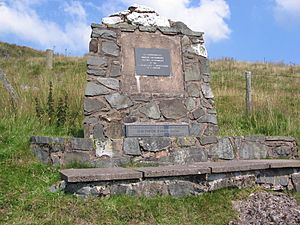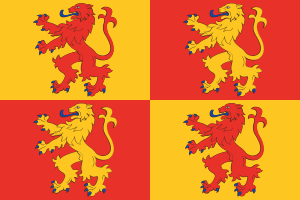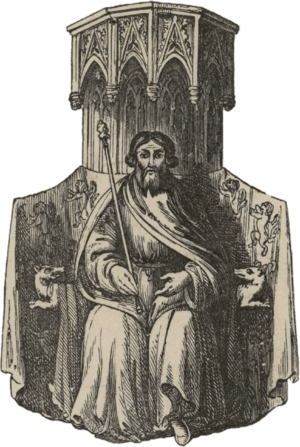Glyndŵr rebellion facts for kids
Quick facts for kids Glyndŵr rebellion |
|||||||||
|---|---|---|---|---|---|---|---|---|---|
 Portrait of Owain Glyndŵr and Welsh rebels |
|||||||||
|
|||||||||
| Belligerents | |||||||||
| Commanders and leaders | |||||||||
The Glyndŵr rebellion was a big uprising in Wales. It was led by Owain Glyndŵr against the Kingdom of England. This happened during the Late Middle Ages, from 1400 to about 1415. It is also called the Welsh Revolt.
At its strongest, between 1403 and 1406, Owain controlled most of Wales. He captured many strong English castles. He even set up a Welsh parliament in Machynlleth. This revolt was the last major fight for Welsh independence. Wales became part of England in 1543.
The uprising started in 1400. Owain Glyndŵr was from an old Welsh royal family. He claimed the title of Prince of Wales. This happened after a disagreement with an English lord. By 1404, Owain had won many battles and sieges. He was crowned Prince of Wales. People from Scotland, France, and Spain were there.
Owain then called a Welsh parliament. He planned to bring back old Welsh laws. He also wanted an independent Welsh church. He even planned to build two universities. Owain also made an alliance with Charles VI of France. In 1405, a French army came to Wales to help.
But in 1406, Owain's forces lost battles in south-east Wales. The Welsh were greatly outnumbered. People in Wales were also getting tired. England had blocked their trade. English armies also caused a lot of damage.
By 1407, the English had taken back Anglesey. They also took back much of south Wales. In 1408, they captured Aberystwyth Castle. Then Harlech Castle fell in 1409. This ended Owain's control over land. But Owain himself was never caught. He refused two offers of pardon from King Henry V. Small groups of Welsh fighters kept going for years. They used hit-and-run tactics. Owain disappeared in 1415. His son, Maredudd ab Owain Glyndŵr, accepted a pardon in 1421. This officially ended the rebellion.
Contents
Why the Rebellion Started
King Richard II and Wales
In the late 1300s, Richard II of England wanted more power. He tried to control his kingdom better. He focused on Wales, which was a mix of different areas. Richard gave land to his favorite people. He also gave important jobs to many Welsh people. This was a good time for some Welsh families. But English nobles did not like Richard's actions.
In 1399, Henry Bolingbroke returned to England. He had been sent away by Richard. Henry gathered an army to take back his lands. Richard came back from Ireland to Wales to fight Henry. But Richard was captured and put in prison. Parliament then made Henry Bolingbroke king. Richard died in prison in 1400.
Many Welsh people had supported King Richard. He was the son of Edward, the Black Prince, who was also Prince of Wales. With Richard gone, Welsh people had fewer chances to get ahead. Many felt unsure about their future. There was a lot of unrest near the border of England and Wales.
Owain Glyndŵr's Dispute
The rebellion began with a fight between Owain Glyndŵr and an English lord. This lord was Reginald Grey, 3rd Baron Grey de Ruthyn. Owain and de Grey had a long argument over land. Owain had won a court case about the land under King Richard. But de Grey was loyal to the new King Henry. He used his influence to change the court's decision.
Another story says that de Grey did not tell Owain about a royal order. This order told Owain to join the king's army in Scotland. Owain was supposed to provide soldiers for the king. By not getting the message, Owain seemed to disobey King Henry. This made the king angry.
The Welsh Revolt: 1400–1415
On September 16, 1400, Owain took action. A small group of his followers declared him Prince of Wales. This was a very bold statement. Owain's men quickly moved through north-east Wales. They attacked towns like Ruthin and its castle. Other towns like Denbigh and Flint were also attacked. By September 23, Owain was moving south. He attacked Powis Castle and Welshpool.
Around the same time, the Tudur brothers from Anglesey started fighting the English. The Tudors of Penmynydd were a powerful family. They had been close to King Richard II. Gwilym ap Tudur and Rhys ap Tudur were military leaders. They joined Owain's revolt. They were Owain's cousins.
King Henry IV was returning from Scotland. He turned his army towards Wales. By September 26, he was ready to invade. Henry led his army through North Wales. Bad weather and Welsh fighters attacked him often. On Anglesey, he burned villages and monasteries. Rhys ap Tudur led an ambush against the king's forces. The English fled back to Beaumaris Castle. By October 15, Henry was back in England. He had not achieved much.

In 1401, the revolt grew stronger. Much of northern and central Wales joined Owain. English towns and castles were attacked. Even in the south, there were reports of trouble. King Henry sent Henry "Hotspur" Percy to restore order. An offer of pardon was made to most rebels. But Owain and his cousins, Rhys and Gwilym ap Tudur, were not included.
The Tudurs knew they needed a way to bargain. They decided to capture Conwy Castle. The castle had only 15 soldiers and 60 archers. But it was strong and well-supplied. On April 1, a carpenter entered the castle. He attacked the guards and opened the gate. This let the rebels in. Hotspur arrived with more men. But he could not get into the strong fortress. He had to negotiate. An agreement was reached, but the king changed it. Finally, on June 24, an agreement was made. But nine of the defenders had to face justice.
Owain also won his first big battle. This was at Mynydd Hyddgen in May or June. Owain's army of a few hundred was camped in a valley. About 1,500 English and Flemish settlers attacked them. Owain's smaller army fought back. They reportedly killed 200 of the attackers. The situation was serious. King Henry sent another army in October. This time he attacked central Wales.
Henry's forces went through Powys to Strata Florida Abbey. This abbey was known to support Owain. Henry wanted to stop the revolt from spreading south. Owain's forces attacked Henry's supply lines. But they refused to fight a big battle. Henry's army had to retreat. They returned to England with little success. The year ended with a battle at Caernarfon Castle. This battle was not decisive.
The English worried that the revolt would grow. They feared it would attract supporters of the old King Richard. Hotspur complained that he was not getting enough help. He thought Henry's harsh rules only made the revolt worse. He believed that talking to Owain might end the fight. Hotspur may have even talked secretly with Owain.
New Laws Against the Welsh
The king's supporters did not agree with Hotspur. They created new laws against the Welsh. These were called the Penal Laws against Wales in 1402. They were meant to show English power in Wales.
These laws stopped Welshmen from buying land in England. They could not hold important jobs in Wales. They could not carry weapons. They could not own castles or defend their homes. Welsh children could not be educated or learn trades. An Englishman could not be found guilty if a Welshman sued him. Welshmen faced harsh penalties for marrying English women. Englishmen who married Welsh women lost their rights. All public gatherings were forbidden.
These laws made many Welsh people angry. Many who had tried to work with the English now felt pushed into the rebellion. The middle ground between Owain and Henry disappeared.
The Revolt Spreads
In 1402, Owain captured his enemy, Reginald Grey, 3rd Baron Grey de Ruthyn. This happened in an ambush near Ruthin. Owain held him for a year. He only released him after King Henry paid a large ransom. In June 1402, Owain's forces fought an army led by Sir Edmund Mortimer. This battle was at Bryn Glas in central Wales. Mortimer's army lost badly. Mortimer himself was captured.
Owain offered to release Mortimer for a ransom. But King Henry IV refused to pay. Mortimer had a strong claim to the English throne. So, Henry did not want him released quickly. Because of this, Sir Edmund made an alliance with Owain. He married one of Owain's daughters, Catrin.

In 1403, the revolt spread across all of Wales. Owain moved west and south. He marched down the Tywi Valley. Many villages joined him. English estates and castles fell. Finally, Carmarthen, a main English stronghold, was captured. Owain then attacked Glamorgan and Gwent. Abergavenny Castle was attacked and the town burned. Owain moved down the River Usk valley. He burned Usk and took Cardiff Castle and Newport Castle.
Reports said that Welsh students left University of Oxford to join Owain. Welsh workers also left England to return to Wales. In north Wales, Owain's supporters attacked Caernarfon Castle again. This time they had French help. They almost captured it. In response, Henry of Monmouth (King Henry IV's son) burned Owain's homes.
On July 10, 1403, Hotspur rebelled against King Henry. He challenged Henry's right to be king. He raised his army in Chester. Henry of Monmouth, only 16, marched north to meet Hotspur. On July 21, Henry reached Shrewsbury before Hotspur. This forced Hotspur's army to camp outside the town. Henry forced a battle before Hotspur's father could join him.
So, on July 22, Henry fought the rebels. Prince Henry was badly hurt by an arrow in his face. But he kept fighting. When Hotspur was killed, the rebels' fight weakened. By the end of the day, Hotspur was dead. His rebellion was over. Many thousands of men were killed or hurt.
In the summer of 1404, Owain captured Harlech and Aberystwyth. He wanted to show he was a serious ruler. He held court at Harlech. He appointed Gruffydd Young as his chancellor. Soon after, he called his first Welsh Parliament. This was at Machynlleth. There, he was crowned Prince of Wales. Important church leaders and people joined him. English control was reduced to a few isolated castles and towns.
Alliances and French Help
Owain showed his new power by making a deal. This was the "Tripartite Indenture" in February 1405. He made it with Edmund Mortimer and Henry Percy. They agreed to divide England and Wales among them. Wales would stretch to the rivers Severn and Mersey. This included parts of Cheshire, Shropshire, and Herefordshire. Local English towns had stopped fighting. They were making their own deals with the rebels.
There were rumors that old allies of King Richard II were sending money to Wales. Monks were also helping the rebellion. The Percy rebellion was still active. It did not end until 1408. Owain was using the political situation to his advantage.
Things were also getting better internationally. Owain sent Gruffydd Young to France in 1404. They negotiated a treaty with the French. This treaty promised French help to Owain and the Welsh. Joint Welsh and French forces had already attacked Kidwelly Castle in 1403. The Welsh also got help from Brittany and Scotland.
The Rebellion Weakens
In 1406, Owain announced his plans for Wales. He wanted an independent Welsh state. It would have its own parliament and church. He planned two national universities. He also wanted to bring back the old laws of Hywel Dda. By this time, most French forces had left. Politics in Paris had changed. Even Owain's letter to the French king did not help.
There were other signs of trouble. Early in 1406, Owain's forces lost battles. These were at Grosmont and Usk at the Battle of Pwll Melyn. It seems that Henry of Monmouth defeated Welsh raiding parties. These parties were led by Rhys Gethin and Owain's son, Gruffudd ab Owain Glyndŵr. Owain's brother, Tudur ap Gruffudd, may have died at Usk. Gruffudd was captured and sent to the Tower of London. He died in prison six years later.
King Henry also used harsher tactics. After the battle near Usk, King Henry had 300 prisoners beheaded. An abbot was killed while helping the wounded. More seriously, English forces landed in Anglesey. They pushed the Welsh back. Resistance in Anglesey ended by late 1406.
The English also changed their strategy. Instead of big attacks, Henry of Monmouth used an economic blockade. He used the castles still under English control. He slowly took back Wales. He cut off trade and weapons supplies. By 1407, this plan was working. Many people in Flintshire agreed to pay fines for supporting Glyndŵr. Other areas also started to surrender.
By midsummer, Owain's castle at Aberystwyth was under siege. It surrendered that autumn. In 1409, it was Harlech Castle's turn. Owain sent desperate messages to the French for help. There was no answer. Gruffydd Young went to Scotland for help. But nothing came of it. Harlech Castle fell in 1409. Edmund Mortimer died in the final battle. Owain's wife and daughters were captured. They were put in the Tower of London. They all died there before 1415.

Owain remained free. But he was now a hunted leader. The revolt continued in small ways. In 1410, Owain planned a last raid into Shropshire. Many of his loyal commanders were with him. But the raid went wrong. Many leaders were captured. Rhys Ddu, one of Owain's most loyal commanders, was captured. He was taken to London and executed. His head was put on London Bridge. Other leaders were also executed.
In 1412, Owain captured Dafydd Gam. Dafydd Gam was a Welsh supporter of King Henry. Owain later released him for a ransom. This was the last time Owain was seen alive by his enemies. As late as 1414, there were rumors that a rebel leader was talking to Owain. More soldiers were sent to castles. Outlaws from the rebellion were still active in Snowdonia.
But things were changing. King Henry IV died in 1413. His son, King Henry V, was more forgiving. He offered pardons to the rebel leaders. In 1415, Henry V offered a pardon to Owain. This was as he prepared for war with France. There were talks with Owain's son, Maredudd ab Owain Glyndŵr. But nothing came of it. In 1416, Maredudd was offered a pardon but refused. Maybe his father Owain was still alive. Maredudd finally accepted a pardon on April 8, 1421. This suggests that Owain Glyndŵr had finally died.
The Annals of Owain Glyndwr say that in 1415, Owain went into hiding. His hiding place was unknown. Many said he died. But some believed he did not. The exact date of his death is still not known. But most historians think he died in 1415.
After the Rebellion
By 1415, England fully ruled Wales again. The main rebels were dead, in prison, or very poor. Almost every family in Wales was affected. The cost in lives and property was huge. Wales was already a poor country. It became even poorer from fighting and blockades.
Travelers reported ruined castles and abbeys. Grass grew in the market squares of many towns. Welsh trade almost stopped. Land that used to be farmed was now empty. Even in 1492, an official still blamed the revolt for problems.
Many important families were ruined. The Tudors no longer had power in Anglesey. But the third Tudor brother, Maredudd, went to London. He started a new future for his family. Others surrendered and made peace. Henry Dwn had attacked Kidwelly Castle. He made peace and avoided paying fines. He even helped rebels and plotted against the king. But his grandson fought for Henry V in 1415.
Some of Owain's supporters went into exile. Henry Gwyn left Wales forever. He died fighting for France against his old comrades. Gruffydd Young also lived in exile. He became a bishop in Scotland and North Africa.
New laws were put in place to stop more uprisings. These laws stayed until Henry VII of England became king. Henry VII was also known as Henry Tudor. He was part-Welsh and from the Tudor family. Until then, Welsh people could not own property in Welsh towns. They could not serve on juries. They could not marry English people. They could not hold any royal office. Also, a Welshman's statement could not be used against an Englishman in court.
However, some Welshmen were given the same legal rights as Englishmen. These included Edmund and Jasper Tudor. They were half-brothers of Henry VI of England. Their father, Owen Tudor, was arrested for secretly marrying the Queen. But Henry VI released him and included him in the royal household.
The Glyndŵr rebellion was the last major Welsh fight for independence. Wales was officially joined with England by the Laws in Wales Acts 1535–1542. These laws were passed during the reign of King Henry VIII. He was from the Tudor family. The laws came into effect in 1543.
|



